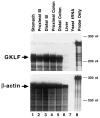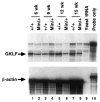Expression of the gut-enriched Krüppel-like factor gene during development and intestinal tumorigenesis
- PMID: 9428642
- PMCID: PMC2330259
- DOI: 10.1016/s0014-5793(97)01465-8
Expression of the gut-enriched Krüppel-like factor gene during development and intestinal tumorigenesis
Abstract
We examined the expression of GKLF (gut-enriched Krüppel-like factor), a recently identified zinc finger-containing transcription factor, in mice during development using the ribonuclease protection assay. In the adult, the level of GKLF transcript is abundant throughout the gastrointestinal tract. Between embryonic days 10 and 19 (E10 and E19) of development, the initial level of whole embryo GKLF transcript is low but begins to rise on E13 and peaks on E17. In the newborn, GKLF transcript level is higher in the colon than in the small intestine although the levels in both organs rise with increasing age. Expression of GKLF was also examined in the intestinal tract of the Min mouse, a model of intestinal tumorigenesis. The level of GKLF transcript is significantly decreased in the intestine of Min mice during a period of tumor formation when compared to age-matched control littermates. Our findings indicate that GKLF expression correlates with certain periods of gut development and is down-regulated during intestinal tumorigenesis, suggesting that GKLF may play a role in gut development and/or tumor formation.
Figures





References
-
- Gordon JI, Hermiston ML. Curr Opin Cell Biol. 1994;6:795–803. - PubMed
-
- Simon TC, Gordon JI. Curr Opin Genet Dev. 1995;5:577–586. - PubMed
-
- Wright NA, Irwin M. Cell Tissue Kinet. 1982;15:595–609. - PubMed
-
- Kaufman MH. In: The Atlas of Mouse Development. Kaufman MH, editor. Academic Press; San Diego, CA: 1992.
-
- Traber PG, Silberg DG. Annu Rev Physiol. 1996;58:275–297. - PubMed
Publication types
MeSH terms
Substances
Associated data
- Actions
Grants and funding
LinkOut - more resources
Full Text Sources
Molecular Biology Databases

